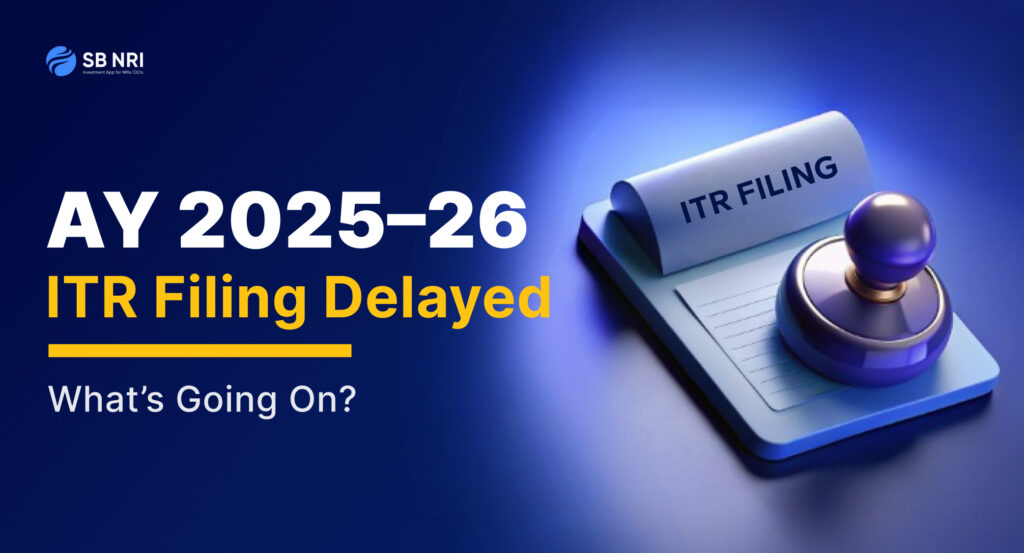
Update (as of 15, July, 2025) : The e-filing is LIVE now. Check the new due-date.
You’re ready with your documents. You know the due date is July 31. But when you log in to the income tax portal—nothing. The system shows e-filing will be enabled soon. A message like the one below is displayed.

If you’re wondering why e-filing isn’t open yet for AY 2025–26 (FY 2024–25), you’re not alone. This includes many NRIs who wish to file their returns early while managing taxes from abroad. The Income Tax Department has released all the forms, but filing is still on hold. Let’s break it down.
All ITR Forms Are Out—So What’s the Hold-Up?
Yes, all seven ITR forms (from ITR-1 to ITR-7) have been notified by the Income Tax Department. These include:
- ITR-1 (Sahaj): For salaried individuals earning up to ₹50 lakh
- ITR-4: For freelancers, small businesses, and professionals under presumptive income schemes
- ITR-2, 3, 5, 6, and 7: For other categories like HUFs, companies, LLPs, and trusts
In addition, a revised ITR-U form has been released under the Finance Act, 2025. You can now revise returns for up to 48 months under specific conditions.
But here’s the catch: None of these can be submitted yet via the e-filing portal.
Why Can’t You File Yet?
The Income Tax Department may have released the forms, but they haven’t enabled e-filing utilities—the tools that allow you to actually file your return online.
These utilities validate and upload your data, whether you use:
- Offline utilities (Excel or JSON)
- The online ITR form on incometax.gov.in
Until those are live, no return—no matter how prepared—is eligible for submission.
This impacts not just resident taxpayers but NRIs who are planning visits or rely on their tax consultants in India. Without these utilities, even they can’t proceed.
So What Are These Utilities, Exactly?
Each year, the tax department releases updated e-filing utilities to ensure your data matches the required format (schema) and integrates smoothly with their backend systems.
There are three main formats:
- Offline Utility (JSON or Excel): Used by tax professionals and bulk filers
- Online E-Filing Portal: Most commonly used by salaried individuals
- Pre-filled XML/JSON: Populates your data automatically from previous filings and Form 26AS
Without these utilities, there’s no backend processing—so the form can’t be submitted.
When Will E-Filing Start?
The Income Tax Department hasn’t confirmed an official start date, but based on media reports and past trends:
- Simpler forms like ITR-1 and ITR-4 are expected to go live between late May and early June
- Last year, ITR-1, ITR-2, ITR-4, and ITR-6 were enabled for e-filing on April 16, 2024
The delay this year is likely due to changes in the schema and system upgrades being rolled out in phases.
What Should You Do Now?
Even though you can’t file just yet, here’s how you can make good use of the time:
- Choose the correct ITR form based on your income type
- Gather documents like Form 16, TDS certificates, interest statements, and AIS
- For NRIs: Keep details of NRO/NRE income, foreign assets, and global income handy
- Cross-check your PAN-Aadhaar linking
- Log in to incometax.gov.in to ensure your profile is up to date
- Subscribe to e-filing alerts or track official notifications
Deadline Reminder: July 31, 2025
Don’t let the delayed start give you a false sense of time. Once e-filing begins, there may still be portal slowdowns, form changes, or technical glitches.
Mark your calendar: July 31, 2025 is the last date to file your ITR (unless extended by the government).
Final Thoughts
While the delay in e-filing is frustrating, it’s not unusual. What matters is that the groundwork is laid—forms are ready, and utilities will follow soon.
For NRIs in particular, planning ahead ensures a smooth filing experience despite being miles away.
Stay prepared. Stay updated. And once e-filing opens, you’ll be ready to submit without stress.
FAQs
1. Why can’t I file my ITR even though the forms are out?
The Income Tax Department has notified all ITR forms for AY 2025–26, but the e-filing utilities required to submit them online or offline are not yet available. Until the utilities are activated on the portal, filing isn’t possible.
2. When will e-filing for AY 2025–26 begin?
There’s no official date announced, but based on previous years, the rollout is likely to begin in phases between late May and early June, starting with simpler forms like ITR-1 and ITR-4.
3. What are e-filing utilities, and why are they important?
E-filing utilities are tools (in Excel, JSON, or online formats) that help taxpayers prepare, validate, and submit ITR forms. Without them, neither online filing nor offline upload is possible.
4. As an NRI, can I file my ITR once utilities go live?
Yes, NRIs can file ITRs using the same utilities as resident taxpayers. Depending on your income sources (Indian salary, rent, capital gains, etc.), you’ll likely use ITR-2 or ITR-3 once they’re activated on the portal.
5. Will the July 31 deadline for filing ITR be extended this year?
As of now, there’s no official announcement about an extension. The deadline for non-audit cases remains July 31, 2025, so it’s best to keep documents ready and monitor the portal for updates.
6. What should I do while waiting for e-filing to open?
Use this time to:
- Gather your income and investment documents
- Check your AIS and Form 26AS
- Link PAN with Aadhaar (if not already done)
- Reconcile your bank/NRO/NRE transactions
- Consult your CA, especially for NRI-specific tax queries
7. Can NRIs use foreign income details in their ITR?
Only income earned or accrued in India needs to be reported in your Indian tax return. However, disclosing foreign assets is mandatory if you’re considered a Resident and Ordinarily Resident (ROR) for the financial year. NRIs and RNORs are exempt from this disclosure unless required otherwise.



